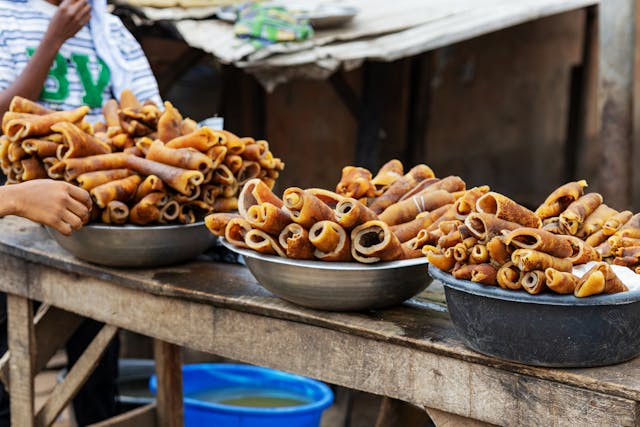Ponmo: The Chewy Delight Nigerians Love

Ponmo (also spelled kpomo or pomo) refers to cow skin that has been processed and cooked to be used as a food ingredient. It's popular across Nigeria and has become an integral part of many traditional dishes, thanks to its unique chewy texture. Here's a look at its uses and origin:
Uses of Ponmo in Nigeria
Culinary Uses:
Soups and Stews: Ponmo is most commonly used in traditional Nigerian soups and stews, such as Egusi soup, Ogbono soup, and Efo Riro. Its ability to absorb flavors makes it a perfect addition to spicy, rich broths.
Jollof Rice and Other Rice Dishes: Sliced ponmo can be added to Jollof rice, fried rice, and other one-pot rice dishes to introduce more texture.
Peppered Ponmo: This dish, sometimes referred to as "Ponmo Alata," is ponmo stir-fried or simmered in a spicy, peppery sauce. It's often served as a side dish or snack.
Street Food: Ponmo is grilled or fried and sold as street food in many parts of Nigeria. It’s typically paired with spicy pepper sauces, making it a favorite snack.
Small Chops: At Nigerian parties, ponmo is often part of the “small chops” selection (a platter of finger foods) alongside other delicacies like puff-puff, samosa, and spring rolls.
Meat Substitute: Ponmo is frequently used as a cheaper alternative to beef or other forms of animal protein. While it contains very little nutritional value compared to regular meat, it is enjoyed for its texture and ability to complement various dishes.
Low-Calorie Food: Ponmo is relatively low in fat and calories, making it a preferred option for those who want the sensation of eating meat but are looking to reduce their fat intake.
Origin of Ponmo
Ponmo is deeply rooted in Nigerian and broader West African cuisine. Its origin is tied to traditional cooking practices, where nothing from the animal was wasted. In many African cultures, it is common to use every part of the cow, including the skin. Over time, ponmo evolved from being a by-product of cattle processing to a delicacy enjoyed by both rural and urban populations.
In Yoruba land, for example, ponmo became particularly popular as a result of its availability and the practicality of using cow skin, which was cheaper and easier to obtain than other cuts of meat. Ponmo was historically used in communal meals, and its chewy texture made it a satisfying component in dishes intended to feed large families or gatherings.
Regional Variations
Yoruba Cuisine: Ponmo is most popular among the Yoruba people in southwestern Nigeria, where it is commonly used in stews and soups. In markets across Lagos and Ibadan, you can find large piles of dried and processed ponmo for sale.
Hausa and Northern Nigeria: Ponmo is also enjoyed in the northern parts of Nigeria, where it is often served as part of street food alongside suya (grilled meat skewers) or other grilled meats.
Igbo Cuisine: Among the Igbo, ponmo is used similarly in soups, though it is less common compared to the Yoruba.
Processing Ponmo
The preparation of ponmo involves boiling or roasting the cowhide to remove the hair, then sun-drying or smoking it for preservation. The cow skin can be processed into different textures: soft, semi-soft, or tough, depending on how it will be used in cooking.
Cultural Significance
Ponmo holds a special place in Nigerian culinary culture, as it represents resourcefulness and the ability to make use of all parts of the animal. It has also become a point of cultural pride, with many Nigerians emphasizing that despite its low cost and simplicity, it is an essential part of their food heritage.
Ponmo has become a beloved ingredient in Nigerian cuisine, widely appreciated for its versatility in soups, stews, snacks, and street foods. Despite its humble origin as cow skin, ponmo is cherished for its chewy texture and ability to absorb flavors, making it a staple in kitchens across the country.
- Photo: Pexels
Uses of Ponmo in Nigeria
Culinary Uses:
Soups and Stews: Ponmo is most commonly used in traditional Nigerian soups and stews, such as Egusi soup, Ogbono soup, and Efo Riro. Its ability to absorb flavors makes it a perfect addition to spicy, rich broths.
Jollof Rice and Other Rice Dishes: Sliced ponmo can be added to Jollof rice, fried rice, and other one-pot rice dishes to introduce more texture.
Peppered Ponmo: This dish, sometimes referred to as "Ponmo Alata," is ponmo stir-fried or simmered in a spicy, peppery sauce. It's often served as a side dish or snack.
Street Food: Ponmo is grilled or fried and sold as street food in many parts of Nigeria. It’s typically paired with spicy pepper sauces, making it a favorite snack.
Small Chops: At Nigerian parties, ponmo is often part of the “small chops” selection (a platter of finger foods) alongside other delicacies like puff-puff, samosa, and spring rolls.
Meat Substitute: Ponmo is frequently used as a cheaper alternative to beef or other forms of animal protein. While it contains very little nutritional value compared to regular meat, it is enjoyed for its texture and ability to complement various dishes.
Low-Calorie Food: Ponmo is relatively low in fat and calories, making it a preferred option for those who want the sensation of eating meat but are looking to reduce their fat intake.
Origin of Ponmo
Ponmo is deeply rooted in Nigerian and broader West African cuisine. Its origin is tied to traditional cooking practices, where nothing from the animal was wasted. In many African cultures, it is common to use every part of the cow, including the skin. Over time, ponmo evolved from being a by-product of cattle processing to a delicacy enjoyed by both rural and urban populations.
In Yoruba land, for example, ponmo became particularly popular as a result of its availability and the practicality of using cow skin, which was cheaper and easier to obtain than other cuts of meat. Ponmo was historically used in communal meals, and its chewy texture made it a satisfying component in dishes intended to feed large families or gatherings.
Regional Variations
Yoruba Cuisine: Ponmo is most popular among the Yoruba people in southwestern Nigeria, where it is commonly used in stews and soups. In markets across Lagos and Ibadan, you can find large piles of dried and processed ponmo for sale.
Hausa and Northern Nigeria: Ponmo is also enjoyed in the northern parts of Nigeria, where it is often served as part of street food alongside suya (grilled meat skewers) or other grilled meats.
Igbo Cuisine: Among the Igbo, ponmo is used similarly in soups, though it is less common compared to the Yoruba.
Processing Ponmo
The preparation of ponmo involves boiling or roasting the cowhide to remove the hair, then sun-drying or smoking it for preservation. The cow skin can be processed into different textures: soft, semi-soft, or tough, depending on how it will be used in cooking.
Cultural Significance
Ponmo holds a special place in Nigerian culinary culture, as it represents resourcefulness and the ability to make use of all parts of the animal. It has also become a point of cultural pride, with many Nigerians emphasizing that despite its low cost and simplicity, it is an essential part of their food heritage.
Ponmo has become a beloved ingredient in Nigerian cuisine, widely appreciated for its versatility in soups, stews, snacks, and street foods. Despite its humble origin as cow skin, ponmo is cherished for its chewy texture and ability to absorb flavors, making it a staple in kitchens across the country.
- Photo: Pexels

